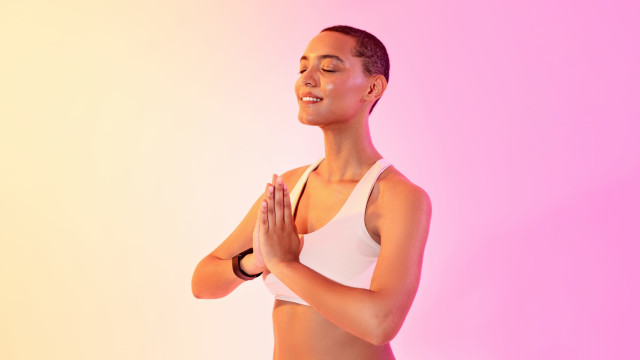Meditation Styles That Work For Me

I wasn't aware of the dozens of meditation styles I could choose from when I first started building a practice. I had the opportunity to learn martial arts, which allowed me to incorporate meditation into my life at a young age. However, the technique I learned was the only style I practiced for more than 20 years.
While I did enjoy this sort of meditation, I only stuck to it because I had no idea there was anything else out there for me.
My First Meditation Experience
I was first introduced to Trataka meditation as part of my martial arts training when I was eight years old. The tradition is focus-oriented and requires students to stare at a single point ahead, such as the flame of a candle, or in my case, a small black dot on the wall.
Concentration wasn't my strong suit; I was a very active child who consistently engaged in various activities. When I first started, I recall my eyes watering and hurting. I remember feeling aches and pains all through my body. Everything about the practice was uncomfortable, and my entire being was screaming for me to stop. However, I had a deep respect for my sensei and martial arts, so I continued to practice.
Over time, the aches stopped, the anxiety decreased, and I began to find peace with it — so much ease that I became an enthusiastic meditator regularly practicing this method in and out of class.
However, I still felt that something was missing.
Many years later, I enrolled in a yoga teacher training that exposed me to new styles of meditation. As I began to practice, I realized that while some techniques worked for me, others were not helpful.
After much trial and error, I reached my meditation sweet spot — a combination of three styles that feel the most authentic to me. They give me everything I look for in a meditation practice: energy, focus, and relief from anxiety.
If you're still trying to figure out which meditation style works best for you, you may want to try this combination.
Breath Awareness Meditation
Focusing on the breath was essential for my martial arts training, but I never considered breath awareness a meditation style. I was introduced to this style of meditation during the very first class of my 200-hour yoga teacher training, and the practice instantly resonated. I fell in love with the fact that I could use something as simple as my breath to anchor my focus and relax my nervous system.
During this time, I started speaking in front of large audiences for work — something I found quite scary. While the Trataka meditation I had learned in my childhood effectively reduced my overall anxiety, I felt it did not calm me down quickly enough before speaking on a stage.
However, bringing my attention to my breath considerably reduced my anxiety and allowed me to become a more dynamic speaker. For this reason, breath awareness meditation is now my go-to when I need to calm down quickly.
Try It
Begin by gently closing your eyes. Bring your awareness to your breath, following the air as you inhale and exhale. Notice any sensation that the inhale brings to your body, including the coolness of the air on the tip of your nose, or feeling your breathe at the back of your neck and into the base of your lungs. When you exhale, become aware of the warmth of the air as it exits your nostrils, and see if you can notice any other sensations. Continue to focus your attention on the breath for two to five minutes.

Mindfulness Meditation
When I first tried mindfulness, it brought me back to a period of my childhood when I spent time looking at the clouds, trying to find shapes in them. Instead of simply noticing a cloud and letting it pass by, I would overanalyze its form, becoming attached to a specific outcome.
Mindfulness is the opposite of this. Like the clouds passing through the sky, we observe our thoughts passing through our minds, but we don't become rigidly attached to any of them. We let them come and go, watching them with a neutral mind as they do so. I find that practicing this style of meditation helps slow down my thoughts, and for this reason, it has become an essential part of my bedtime ritual. As my mind quiets, my body also begins to relax and melt into the mattress, allowing me to fall into a deep, restful sleep.
Try It
Gently close your eyes and bring your awareness to the thoughts in your mind. Imagine these thoughts as clouds passing through a blue sky. When a thought comes to mind, notice it and let it float by without becoming attached to it. If you notice any tendency toward rumination after a particular thought or that your mind starts to wander, gently bring your attention back to observing your thoughts without any judgment. Do this for five minutes and slowly increase the time for as long as it feels comfortable.
Mantra Meditation
Of all the styles of meditation I've tried; mantra meditation has a special place in my heart. This is probably because I have an overly curious and active mind, and learning to use a mantra helps keep my mind busy while I meditate, making it an easier and more enjoyable experience.
When I first came across mantra meditation, I learned to sync the word or phrase to the rhythm of my breath. This quickly resonated with me, as it kept my mind focused. Over time, I've found that it works well when my emotions are active or intense. So whenever somebody or something triggers me, this is my favorite way to recover.
Try It
There are different styles of mantra-based meditations. For this exercise, I want you to use the mantra So Hum. So Hum, translated from Sanskrit, means "I Am That." To meditate with this mantra, gently close your eyes, and on the inhale, silently say to yourself, "So." On the exhale, silently say to yourself, "Hum." Repeat for a few minutes, up to 20. If you find this style of meditation suits you, I encourage you to learn more about Primordial Sound Meditation, Transcendental Meditation, or Vedic Meditation — three forms of mantra-based meditation.
Finding Your Ideal Combination
I believe there is more than one way to find inner peace and freedom from suffering. Pinpointing the meditation style that works for you requires an intimate journey of self-discovery. What ultimately works for you may not work for others, so don't trust outside opinions over your thoughts on the matter. Do your research, practice every day, and see the results. If something doesn't feel right, keep looking. There are plenty of styles to choose from!
The three styles of meditation I have outlined — breath awareness, mindfulness, and mantra — are the ones that I have found work best for me at this time. Of course, this could always change, but I choose to remain open to any shifts.
For now, this combination gives me relief from anxiety, enhances my focus, and provides a stable store of energy throughout the day — precisely what I need from my meditation practice right now.
As you learn more about what meditation style best suits your needs, try this Roundglass course, 21-Day Jump-Start to a Powerful, Joyous Meditation Practice by meditation teacher David Harshada Wagner.









